Louis Moinet Cosmopolis: Official Guinness World Record for Number of Meteorites in a Watch
by Martin Green
One of the great things about the world of watchmaking is that there are still brands that walk to their own beat. They are not influenced by trends, obviously following the money, but rather by their own intricate values and passions. I say their and not it, because these brands are, of course, companies for profit, but their main goal is not to maximize this. Instead, they follow a far more artistic approach that is grounded in the brand’s DNA.
An excellent example of such a brand is Louis Moinet. Over the years, it has carefully carved out a niche in the market and serves this with interesting and original timepieces. It is safe to say that Jean-Marie Schaller, owner and creative director of Louis Moinet, likes to include a few passions of his own in his creations.
Schaller is enamored by fossils, rare stones, and exceptional meteorites. We have already seen in the past how fragments of them were included in Louis Moinet’s timepieces, but now he is upping the game with the Cosmopolis.
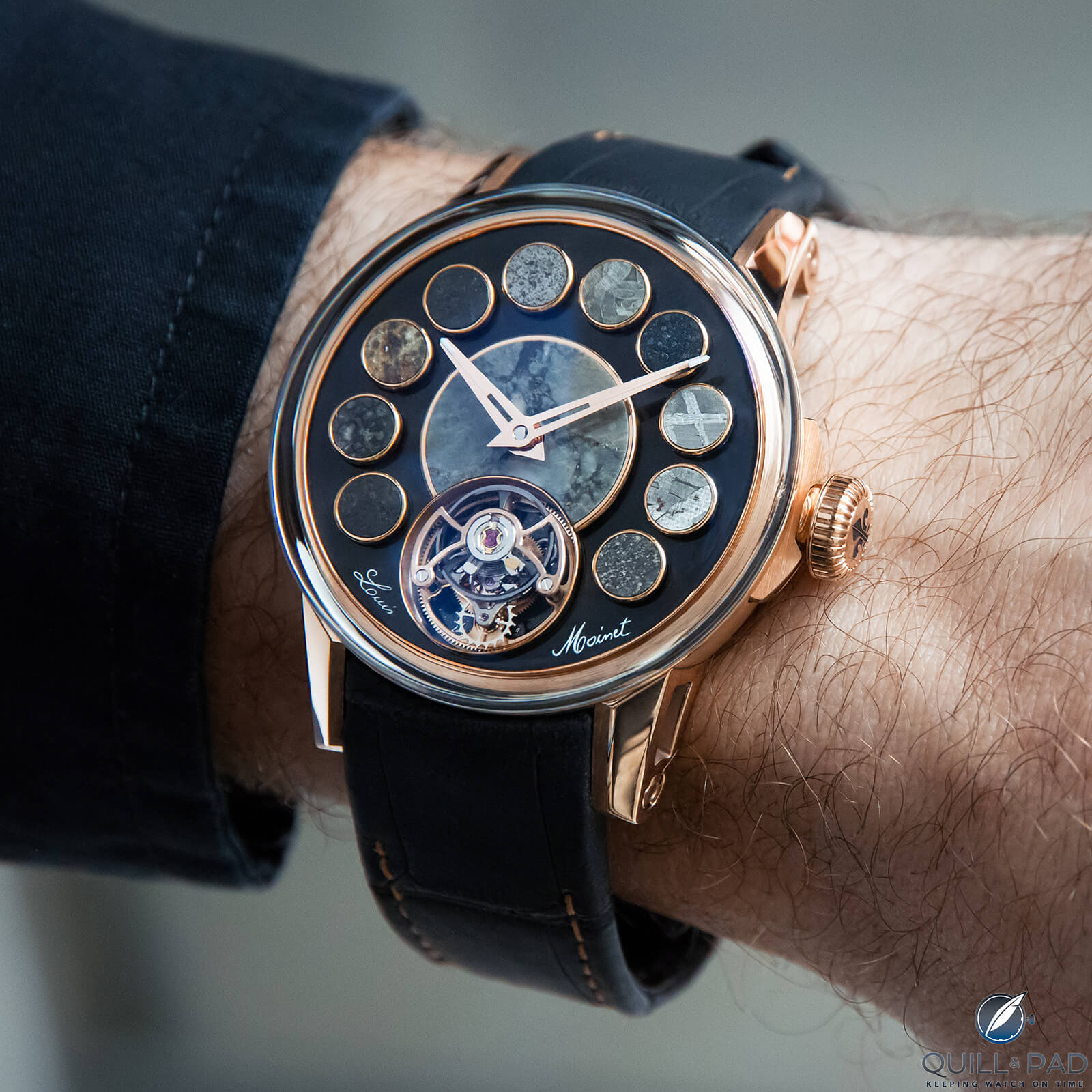
Louis Moinet Cosmopolis
Cosmopolis: True to its name
The name of this watch couldn’t have been more appropriate, as Louis Moinet included pieces from 12 different, and very rare, meteorites from Schaller’s own collection in Cosmopolis. And this earned him the Guinness World Records™ title for the “most meteorite inserts in a watch.”
I wonder if that even matters. What this watch stands for is simply mind-boggling, as not only did these meteorites travel extensive distances and time through the galaxy to crash on earth, they also give us a glimpse of what is out there.

From Wikipedia (so it must be true): “A meteorite is a solid piece of debris from an object, such as a comet, asteroid, or meteoroid, that originates in outer space and survives its passage through the atmosphere to reach the surface of a planet or moon. When the original object enters the atmosphere, various factors such as friction, pressure, and chemical interactions with the atmospheric gases cause it to heat up and radiate energy. It then becomes a meteor and forms a fireball, also known as a shooting star; astronomers call the brightest examples “bolides“. Once it settles on the larger body’s surface, the meteor becomes a meteorite. . . . Most meteoroids disintegrate when entering the Earth’s atmosphere. Usually, five to ten a year are observed to fall and are subsequently recovered and made known to scientists. Few meteorites are large enough to create large impact craters. Instead, they typically arrive at the surface at their terminal velocity and, at most, create a small pit.”
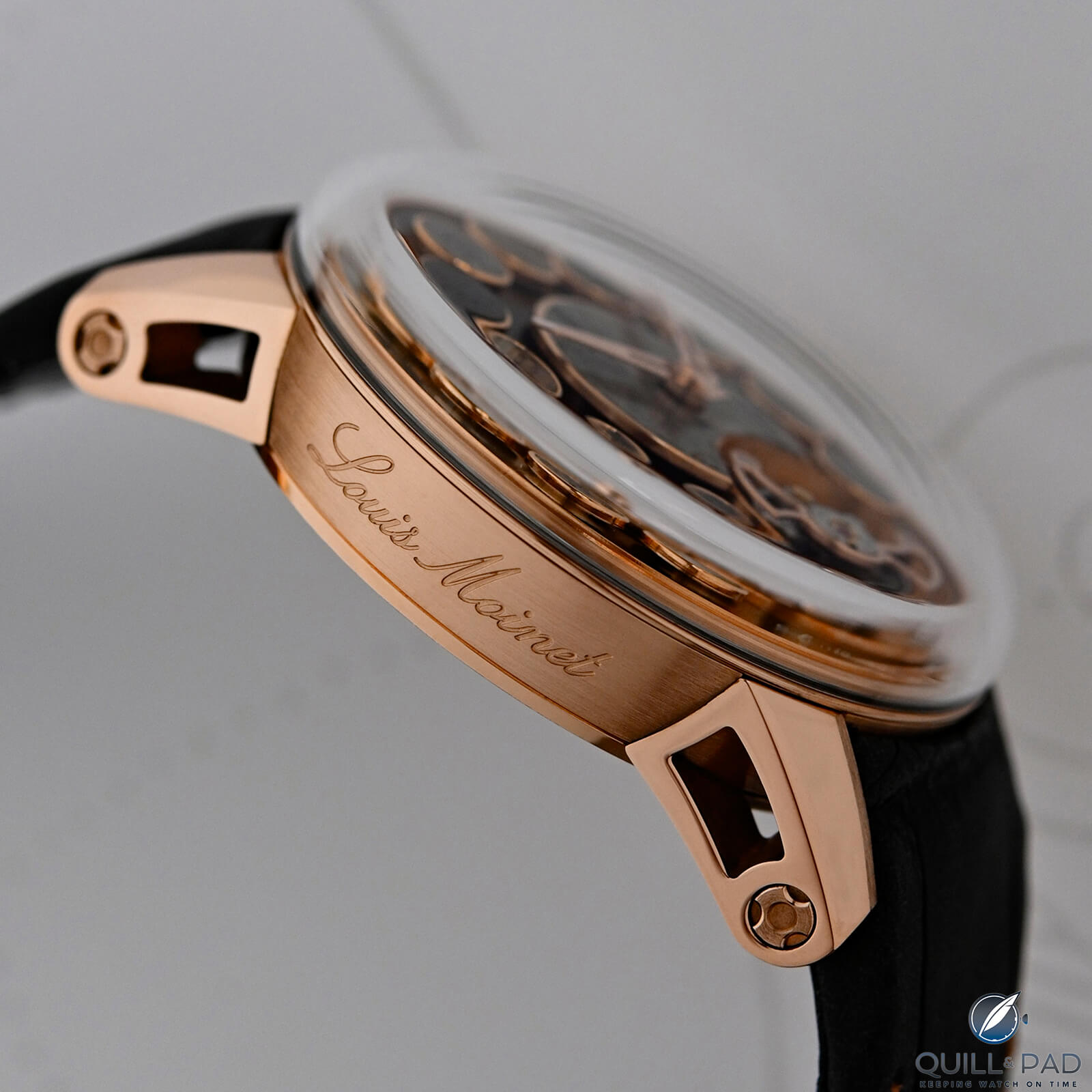
Louis Moinet Cosmopolis
————————————————————————————————————–
—————————————————————————————————–
One of the meteorite segments in the Louis Moinet Cosmopolis is from the Jbilet Winselman meteorite, which was found in the Sahara desert. It contains traces of amino acids, which are connected to the first known traces of life in the cosmos. The segment of the Erg Chech meteorite tells an entirely different story, as this is the oldest magmatic rock known to date and came from a protoplanet that doesn’t exist anymore. It traveled over 4 billion years before it ended up on Earth.
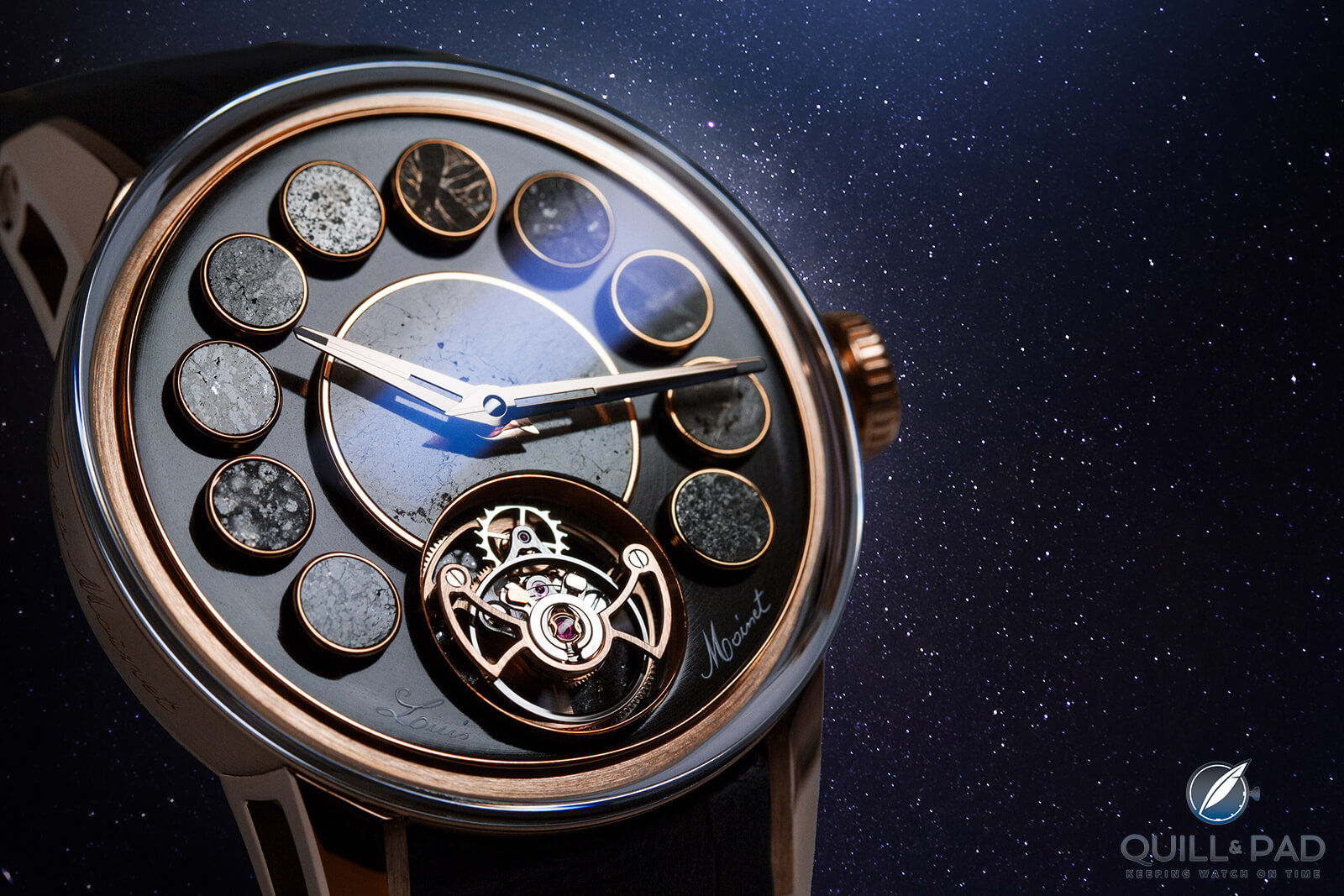
Louis Moinet Cosmopolis
A visual treat
Each of the 12 segments has a fascinating history and origin, and what they have in common is that they all originate from outside our planet. That already makes this the Cosmopolis an impressive watch, but if you know the brand, you also know that there is more. Each segment has been given its own space on the dial to highlight its unique nature. And as they are close together, you can compare the different textures and colors.
There is the Martian meteorite, named Dhofar 1674, which has a beautiful greenish texture, while the segment from the famous Gibeon meteorite found in Namibia shows its distinctive Widmanstätten pattern. This is the pattern most people associate with meteorites.
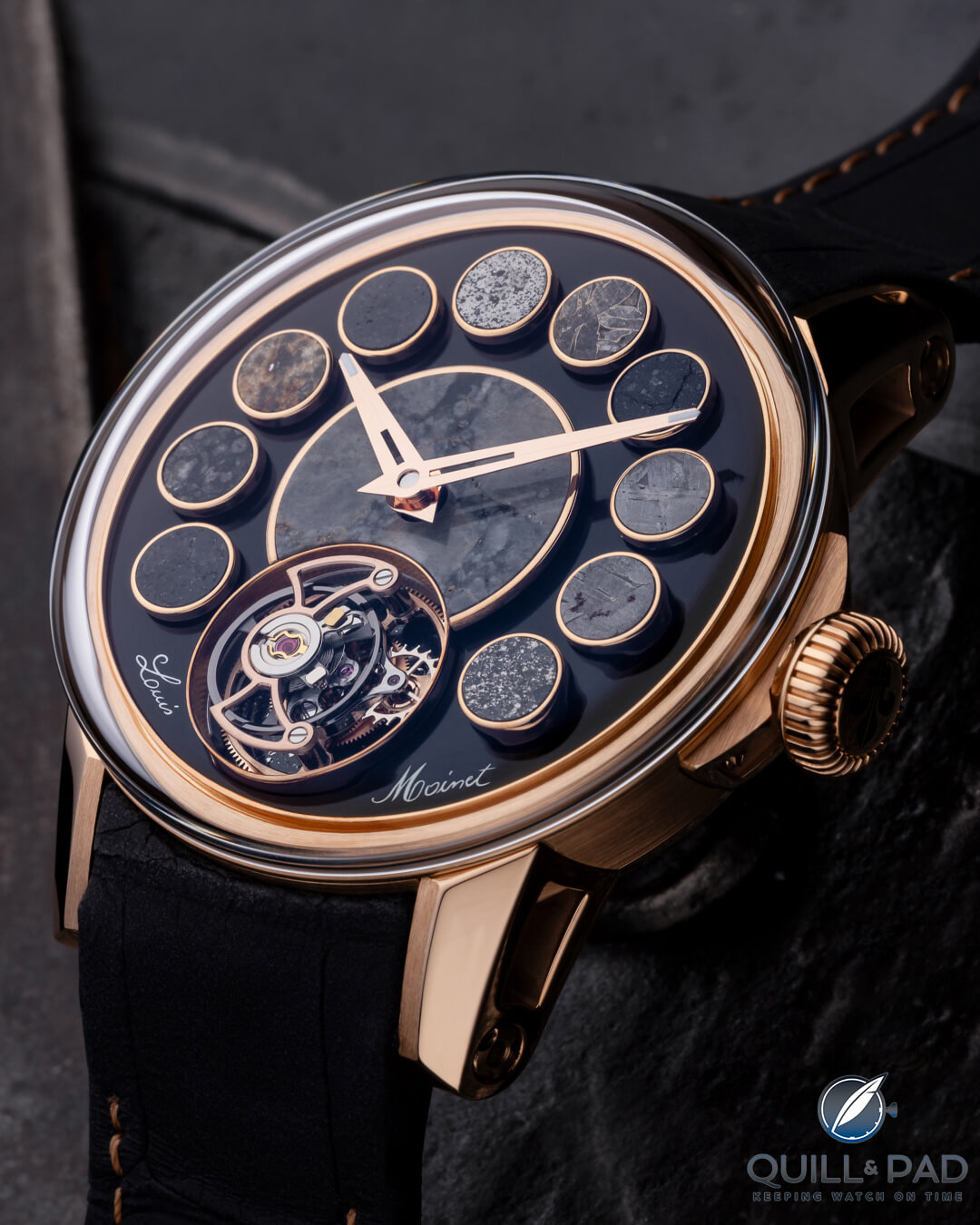
Louis Moinet Cosmopolis
While these segments are neatly positioned on the dial, the center is for the rarest of them all, the lunar meteorite Dhofar 461. The segment from black chondrite, one of the first elements that can go on to become a planet, decorates the back of the tourbillon cage. It is quite fitting for Louis Moinet to equip the Cosmopolis with a device to reduce gravity’s influence on the escapement.
—————————————————————————————————–
—————————————————————————————————–
The 12 Meteorites in the Louis Moinet Cosmopolis
1. Lunar meteorite, Dhofar 461
Origin: Moon
Found near Dhofar, Oman
Dhofar 461 is an extremely rare specimen of lunar meteorite, characterized by a white-speckled interior.
There are currently only 300 recorded lunar meteorites, all of which have been ejected from the Moon during the past 20 million years. Most of these were ejected over the past 100,000 years. On their way to Earth, some of them orbited the sun first before entering Earth’s orbit and atmosphere, where they turn into shooting stars. Their lunar origin has been confirmed by rigorous mineralogical comparisons, their chemical isotopic composition, and with samples collected during the Apollo missions to the Moon.
2. Martian meteorite, Dhofar 1674
Origin: Mars
Found near Dhofar, Oman
Dhofar 1674 is one of the rarest Martian meteorites. It has an extremely special greenish texture. Like most meteorites, Dhofar 1674 was found in the desert, where its blackened exterior contrasts sharply with the surrounding sand.To date, fewer than 300 Martian meteorites have been identified worldwide. This meteorite costs more per gram than gold and platinum combined.
Origin: Meteorite shower
Found in Mexico
The Allende is the most studied meteorite in history. In fact, it has been dubbed the “Rosetta Stone” for the wealth of information it has provided on the formation of the solar system. It is estimated to be 4.567 billion years old and thereby the oldest rock in the solar system.
Origin: Asteroid
Found in Algeria
Erg Chech comes from a volcanic rock and is the oldest magmatic rock known to date. It originated from a protoplanet that has since disappeared, and it is older than the Earth itself. After a journey of more than 4 billion years, it landed about a hundred years ago by the luck of orbital attraction in southern Algeria, in the Erg Chech sea of sand, whence its name. Among the 65,000 recorded meteorites in the world, none share its unique composition. It has an especially stunning appearance that combines green and brown hues and a surface look brought about by a lava flow.
Origin: Asteroid
Found in Morocco, in the western Sahara Desert
This mysterious Jbilet Winselwan meteorite contains traces of amino acids, probably the first known traces of life in the cosmos.
Origin: Asteroid
Found in Russia
The Isheyevo meteorite is a carbonaceous chondrite containing a beautiful sequence of fine layers.
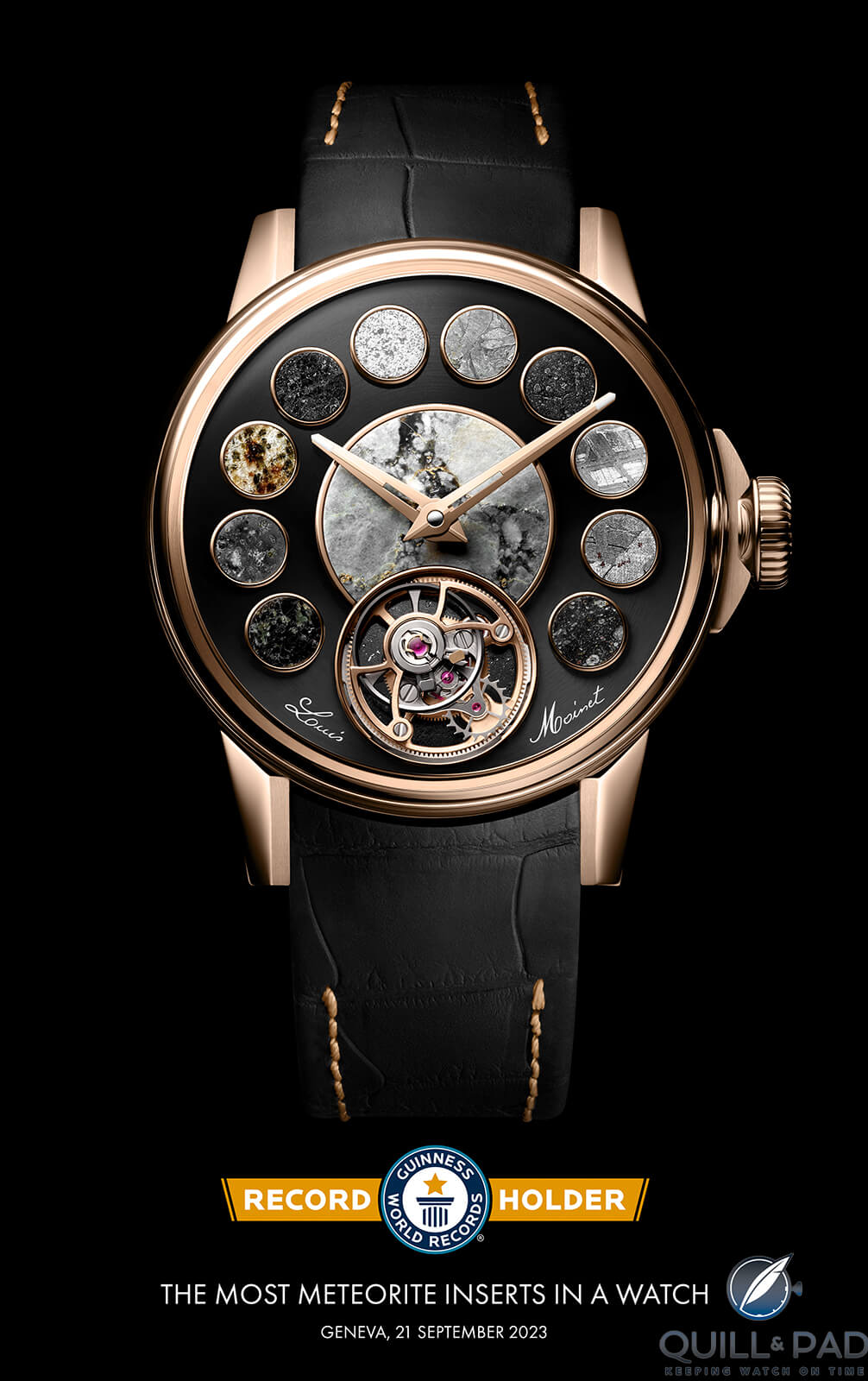
Louis Moinet Cosmopolis
Origin: Asteroid
Found in China
This meteorite used to be known as Armanty, but is now known under the name Aletai. It is composed of a natural and extraterrestrial mix of iron and nickel. It comes from the heart of an asteroid weighing over one hundred tons.
8. Aguas Zarcas meteorite
Origin: Meteorite shower
Found in Costa Rica
The Arguas Zarcas meteorite is part of a meteorite shower that fell in a rainforest in central Costa Rica on April 23, 2019.
Origin: Asteroid
Found in Namibia
The Gibeon meteorite landed in Namibia in prehistoric times. It was named after the nearest city. It is famous for the distinctive Widmanstätten pattern, which is typical for extraterrestrial ferrous rocks.
10. Toluca meteorite
Origin: Asteroid
Found in Mexico
This meteorite probably struck Earth over ten millennia ago. For centuries, Mexicans living near meteorites have used them as a source of metal for various tools. The Toluca meteorite fragments were discovered by the conquistadores in 1776.
Origin: Asteroid
Found in the Sahara Desert
This extremely rare Enstatite EH3 meteorite features microdiamonds of interstellar origin. They are formed in the heart of stars that exploded and became supernova.
12. Black L5 chondrite meteorite
Origin: Asteroid
Found in the Sahara Desert
This black chondrite is a highly shocked meteorite, the result of a gigantic impact in space between two asteroids. Chondrites are considered the first elements that go on to become planets.
—————————————————————————————————–
—————————————————————————————————–
Restrained extravaganza
While Louis Moinet can be a bit extravagant with its watches, something I usually welcome, I love the fact that they exercised restrain here. It are really the rare meteorites that take center stage, aided by the flying tourbillon, but the rest is kept pure and toned down. That doesn’t mean that they play second fiddle, but merely that they support the main goal of this watch amiably. The hands are quite bold, making it that the Cosmopolis also truly serves its role as timekeeper.
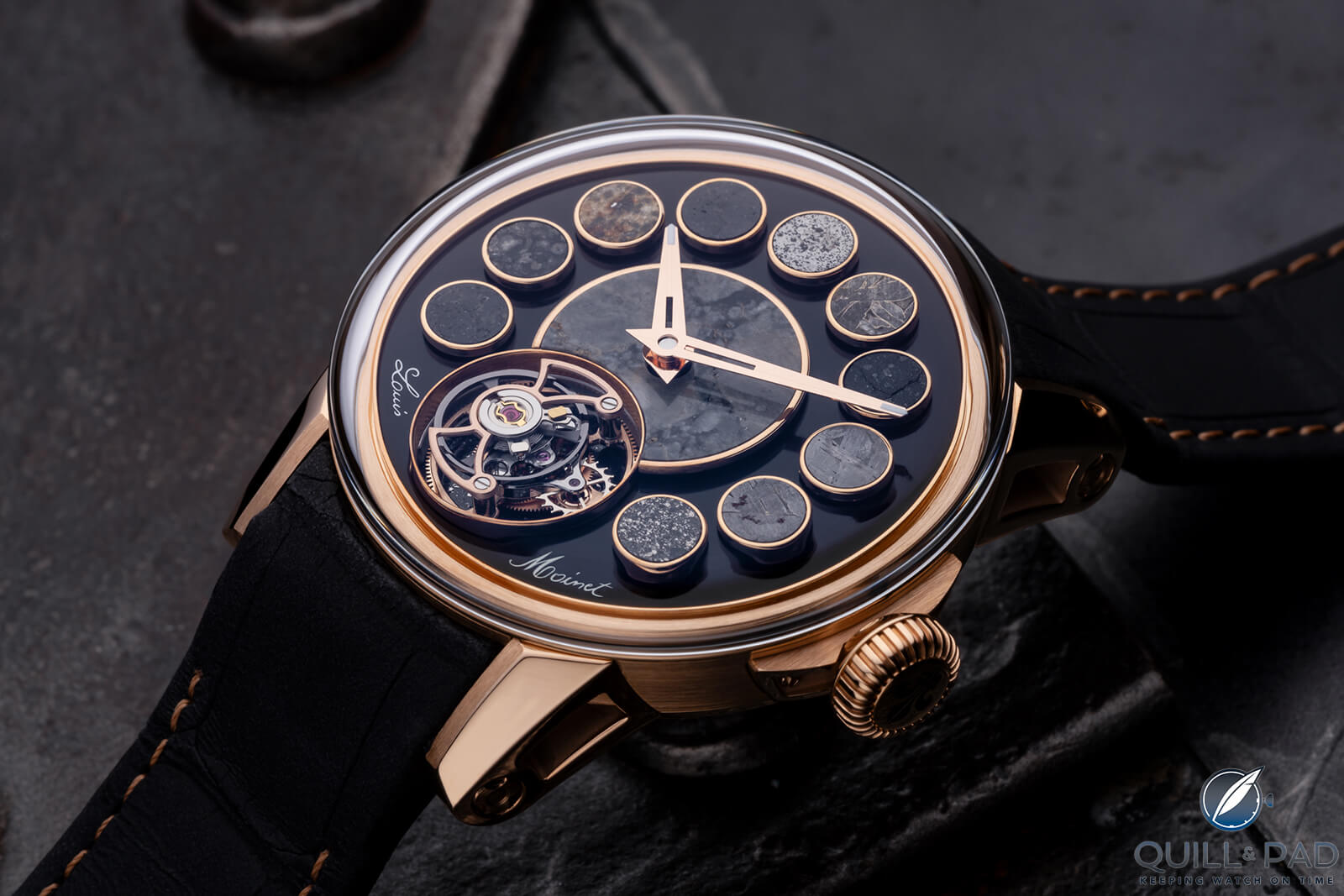
Louis Moinet Cosmopolis
The writing on the dial is kept to an absolute minimum, with only Louis Moinet written in an elegant script. A box crystal gives you the impression that you are looking into a display case of a prestigious museum, like the Smithsonian. It also tones down the bezel and makes the most of the 40.7mm diameter that this watch is. Given its purpose, this is quite modest, making it perfectly wearable.
The red gold case offers a warm contrast with the dial, and its design is in typical Louis Moinet style, with a ‘steampunk’ kind of air over it.

Back of the Louis Moinet Cosmopolis
Technically there is a lot to love. Next to the flying tourbillon is the movement fitted with two mainspring barrels. They are placed upside-down to each other, something known as ‘volte-face.’ This allows for a total power reserve of an impressive 96 hours. Most brands achieve this by also lowering the vibrations per hour, but Louis Moinet kept it at a healthy 4 Hz.
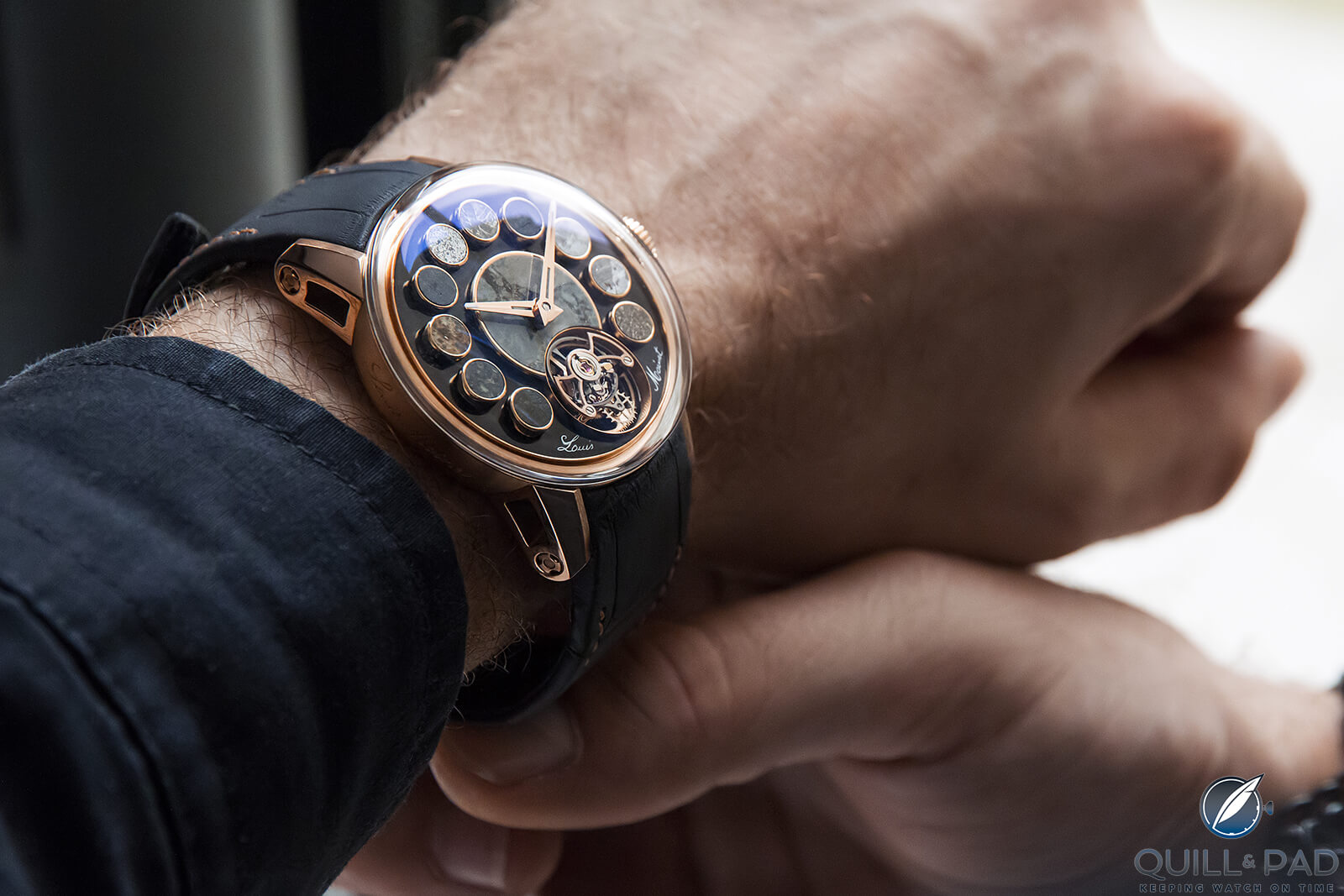
Louis Moinet Cosmopolis
All combined is the Cosmopolis a watch as rare as they come, offering a unique experience, also quite literally, as Louis Moinet will only make one unique piece.
For more information, please visit www.louismoinet.com/collection/cosmic-art/
Quick Facts Louis Moinet Cosmopolis
Case: 40.7 mm, 18-karat red gold
Movement: manual winding caliber with 60-second flying tourbillon, 96-hour power reserve, 28,800 vph/4 Hz frequency
Functions: hours, minutes, tourbillon
Limitation: unique piece
Price: price on request
You might also enjoy:
Louis Moinet Creates 8 Breathtaking Wristwatches In Marvels Of The World Collection Of Unique Pieces
Louis Moinet Astronef: It’s Space, Jim, But Not As We Know It
Louis Moinet Space Revolution 2021: Science Fiction Fantasy Space Battle On The Wrist

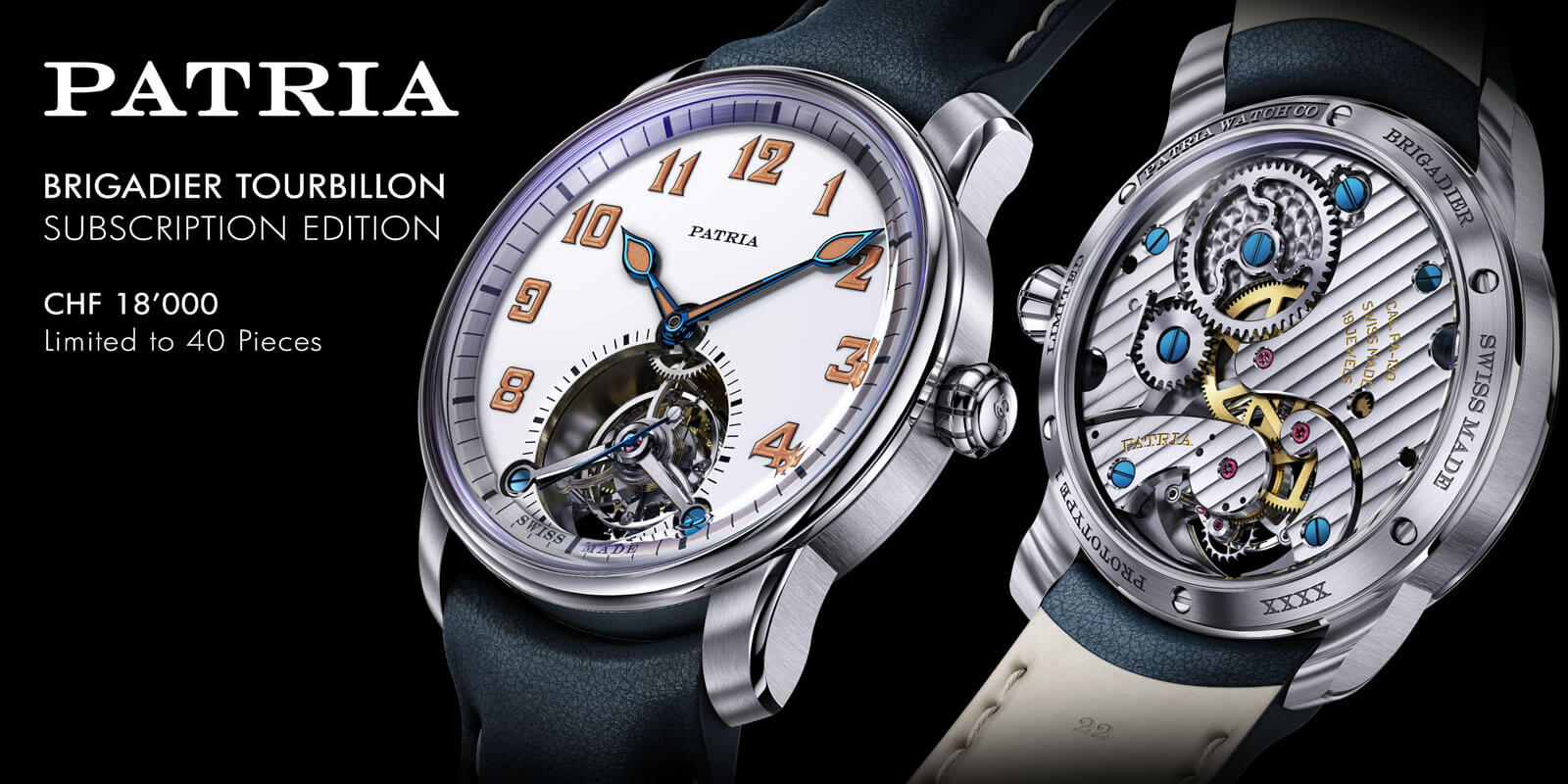

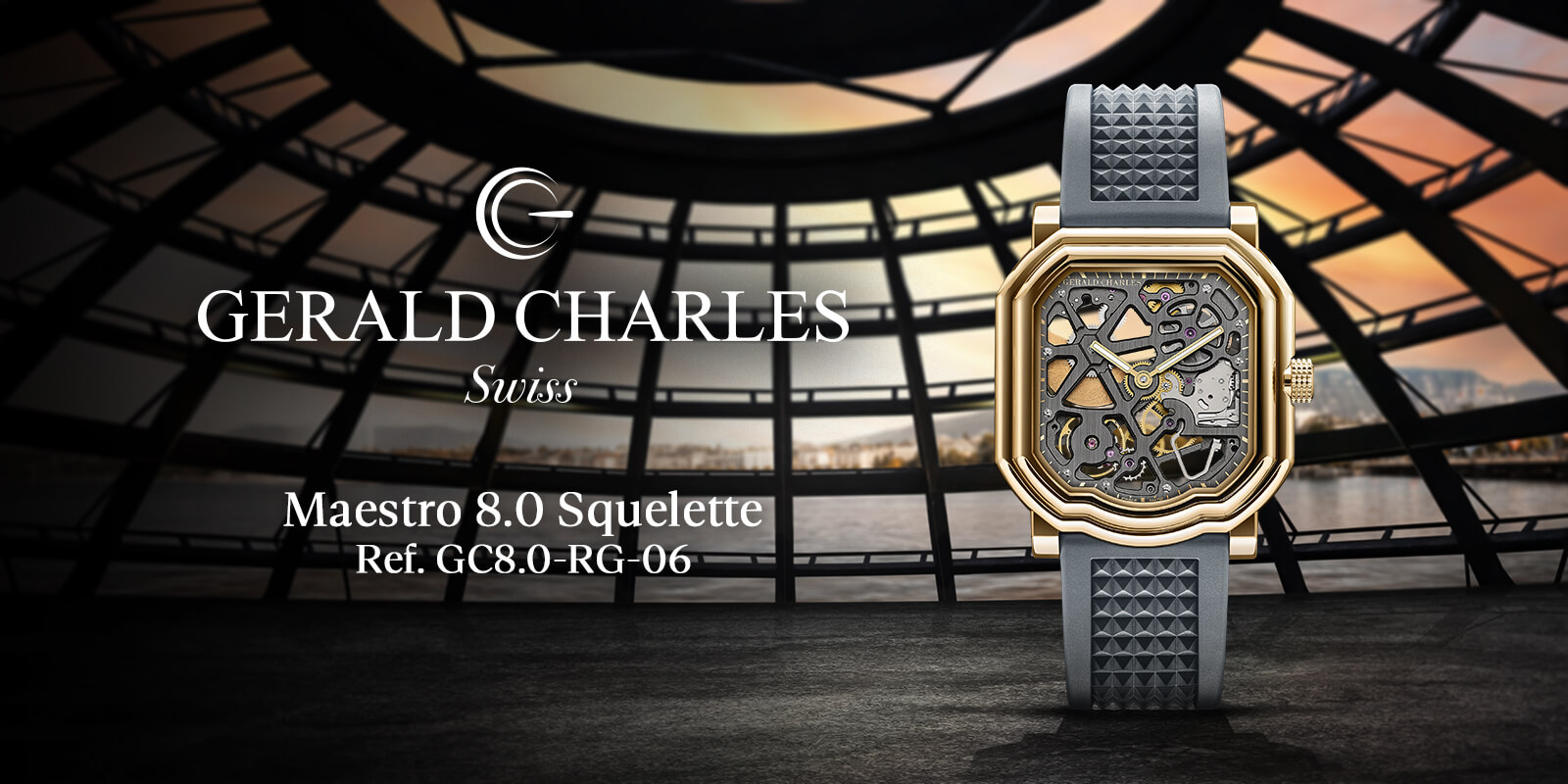


Leave a Reply
Want to join the discussion?Feel free to contribute!